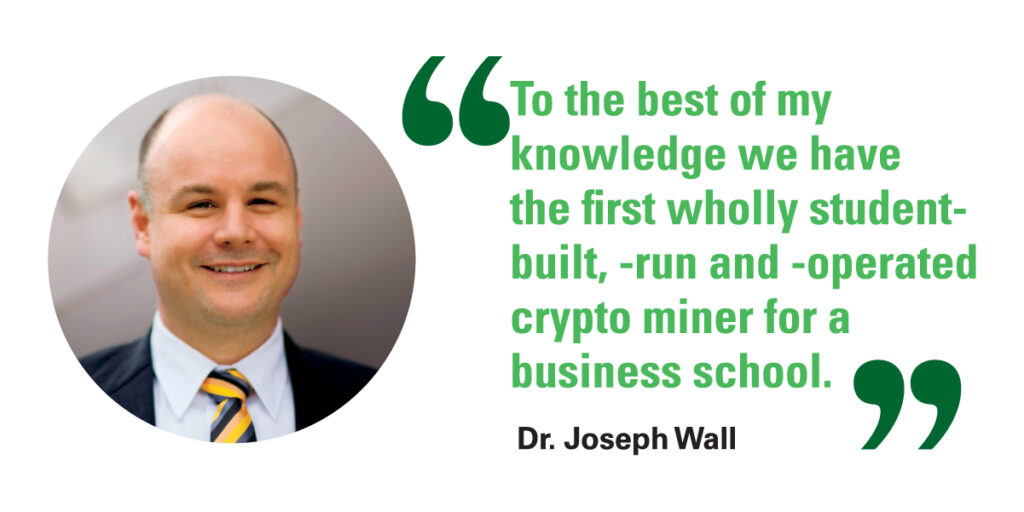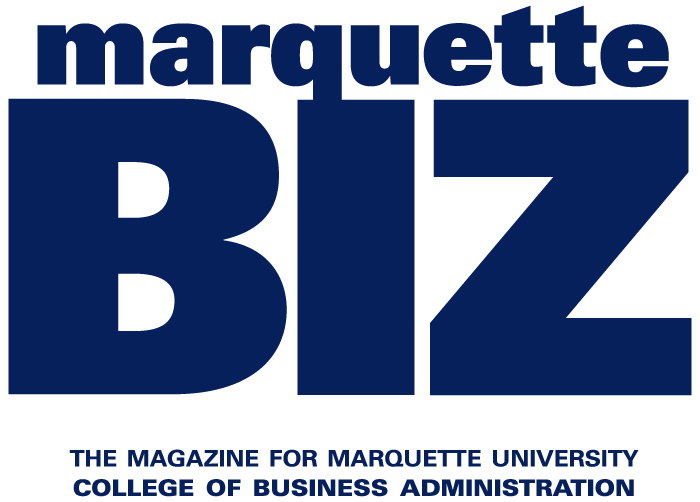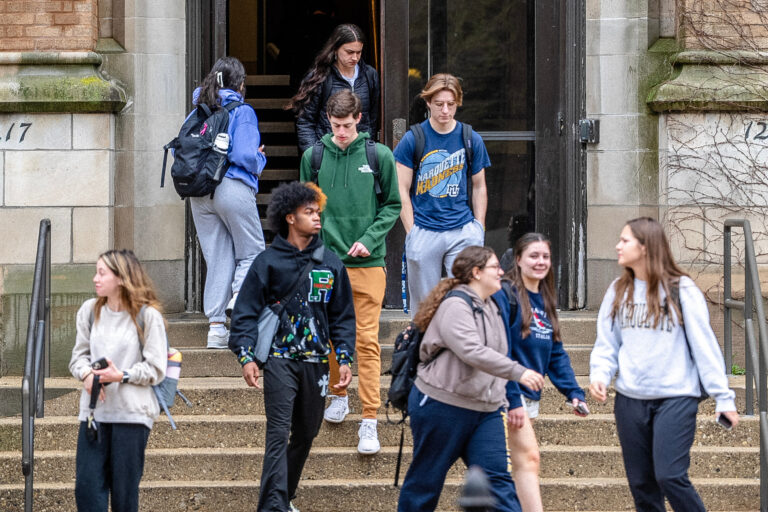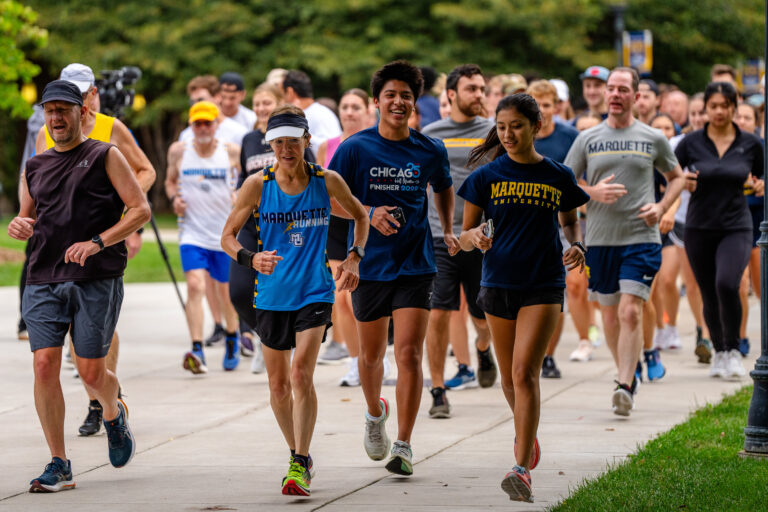With technology shifting the finance industry landscape, the AIM program keeps students prepared for what’s next.

By Diane M. Bacha
For many years, students in Marquette’s Applied Investment Management program would hear eye-popping descriptions of the finance industry’s future. Algorithmic trading, robo-investing, massive-data analysis, cryptocurrency, artificial intelligence, blockchain auditing — these and more disruptive technologies were headed their way.
Today, the possibilities have arrived. To varying degrees, they are the new mainstream in the world of finance and in many parts of the marketplace.
“We used to say a few years ago, ‘Someday you will need to be able to use various fintech tools,’” says Dr. David Krause, referring to the then-emerging area of financial technology. “And now we’re saying, ‘You’d better be able to do this.’”
Krause is an associate professor emeritus of finance and the founding director of AIM, a 17-year-old applied program that gives undergraduate students intensive, hands-on financial analysis experience that includes managing investment portfolios from a research room inside David A. Straz, Jr., Hall. Determined to prepare his students for what’s ahead, Krause has been quick to adapt fintech principles into the AIM curriculum over the years.
“It doesn’t do me any good to only teach students theory and how to build a financial spreadsheet and download data from Bloomberg,” Krause says. “That probably got you a job in 2006. However, in 2022 what gets you a job is being able to do big data analytics, apply artificial intelligence, and be able to understand blockchain and cryptocurrencies.”
To make that happen, the AIM curriculum is constantly evolving. Krause and AIM instructor Dr. Joseph Wall are particularly excited about recent strides that, as Wall puts it, could position Marquette Business to take a leadership role in the application of emerging technologies.

The cryptocurrency challenge
The most recent example of those strides involves cryptocurrency. AIM students are defying establishment thinking about crypto in figuring out ways to acquire it, value it and pitch it as they would traditional finance, or “TradFi,” stocks. “To the best of my knowledge we have the first wholly student-built, run and operated crypto miner for a business school,” says Wall, Grad ’06, associate professor of accounting, who works with students on the cryptocurrency mining project.
The miner is, essentially, a powerful computer connected to the internet that carries out the complex task of verifying cryptocurrency and buying tokens on an exchange. New cryptocurrencies are introduced all the time, and the hope is that AIM students will amass a portfolio that, like a TradFi portfolio, will become a set of assets to manage and grow.
One stumbling block slowing mainstream adoption of cryptocurrency has been the challenge of how to value it. Since valuing a company’s worth is a foundational skill learned in AIM, and since AIM students need to be ready for the future — why not tackle this challenge?
“So, essentially what we did was find a way to analyze something that is a very speculative asset,” says Christian Wilber, Bus Ad ’22. “It turned out it is very hard to do,” Wilber says with a chuckle. “But I think we came up with a really cool model.”
Wilber is part of an informal “crypto club” of AIM students who meet about every two weeks at an off-campus restaurant. When club members sit down to discuss a cryptocurrency, “The key thing we need to find out, brass knuckles, is why invest in this?” says former club member Rishi Kumar, Bus Ad ’22. “Why is it so much better than every other cryptocurrency that is doing the same thing?”
During the fall 2021 semester, the miner was under construction and Wilber, with the help of Wall and club members, was making the first-ever cryptocurrency pitch at AIM’s Friday pitch sessions. The sessions, streamed on YouTube and open to any interested attendees, had until then focused strictly on traditional stocks.
“It was a very exciting challenge to come up with the framework for valuing and presenting a new asset class,” Wilber says. “Much of the work was finding a way to break down the technology and present it in a meaningful way.”
Wilber pitched a crypto called Polkadot. He and the club worked with Wall on a system for valuing Polkadot that considered the technology behind it, its intellectual property value, its relative value compared with other cryptocurrencies, the length of time it’s held before being sold again, and other factors.
“While everyone else is using technical techniques to value cryptocurrencies, we have developed over five methods firmly grounded in fundamentals, which is also very exciting,” says Wall, whose background in the hedge fund industry comes in handy for students. Of the thousands of cryptocurrencies out there, “I would argue maybe 300 have super valuable intellectual property,” he says. “We’ve already pitched three or four, and we’re still building models for more this spring semester. I don’t know of any other school out there doing that.

No time to slow down
There’s plenty more afoot as Wall, Krause and the AIM program run to keep pace with change. Krause has introduced big-data analytics tools to the curriculum. AIM students take turns presenting a researched “fintech story of the day” to track the latest developments. This March, a Friday pitch took place in the virtual world of the metaverse — clunky headsets and all — with plans to do more. Wall secured some time on a quantum computer for the spring semester.
Talk to Krause and Wall for any length of time and you’ll hear a dizzying list of yet more fintech innovations they’re watching: decentralized autonomous organizations; low-code robotic process automation; and NFTs (non-fungible tokens), among others.
Wilber describes Wall and Krause as “full force, nonstop” as they instill a sense of urgency about the changes ahead. Kumar laughs about the day Krause voiced frustration that he couldn’t build a hologram. “A hologram! It kind of shows you that the AIM program is so forward-looking,” Kumar says. “How many other schools are even learning about cryptos and pitching them? Not many.”

Prepared for what’s ahead
Both Wilber and Kumar have jobs as investment banking analysts after graduating, Kumar at Baird and Wilber at CIBC Cleary Gull. They don’t anticipate working with cryptocurrency the way someone in asset management or private wealth management might, but they’re sure their AIM experiences with fintech are valuable.
“You can either fight this thing that’s coming, or you can say, it’s going to help the client and it’s going to help me do my job better,” Kumar says, reflecting on the fact that some skill sets he has learned will likely be automated one day. “It’s a matter of how you’re going to adapt.”
Rushi Shah was an AIM student in 2014, when fintech was still emerging. Today he’s director of product management at YCharts, a financial technology platform built to help financial advisers make investment decisions. Knowing where the industry is headed, says Shah, Bus Ad ’15, gives AIM students a leg up when they enter the workforce, especially paired with AIM’s focus on portfolio analysis and its environment of intellectual curiosity. “The financial services industry is always evolving,” Shah says. “Understanding where our space is headed is really valuable.”
“The world’s going to change,” Kumar says, echoing Shah’s observation. “It’s up to us to change with it. The AIM program has given me a tremendous amount of things to help me prepare for that, and I appreciate that a lot.”




